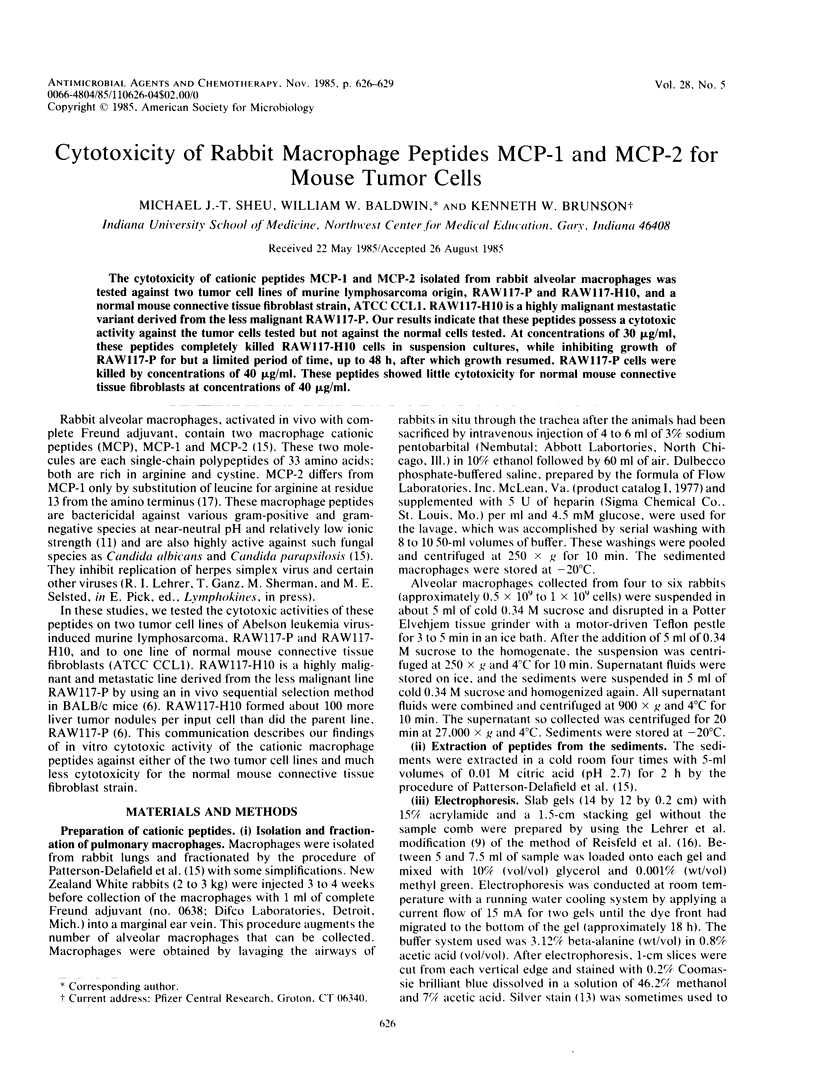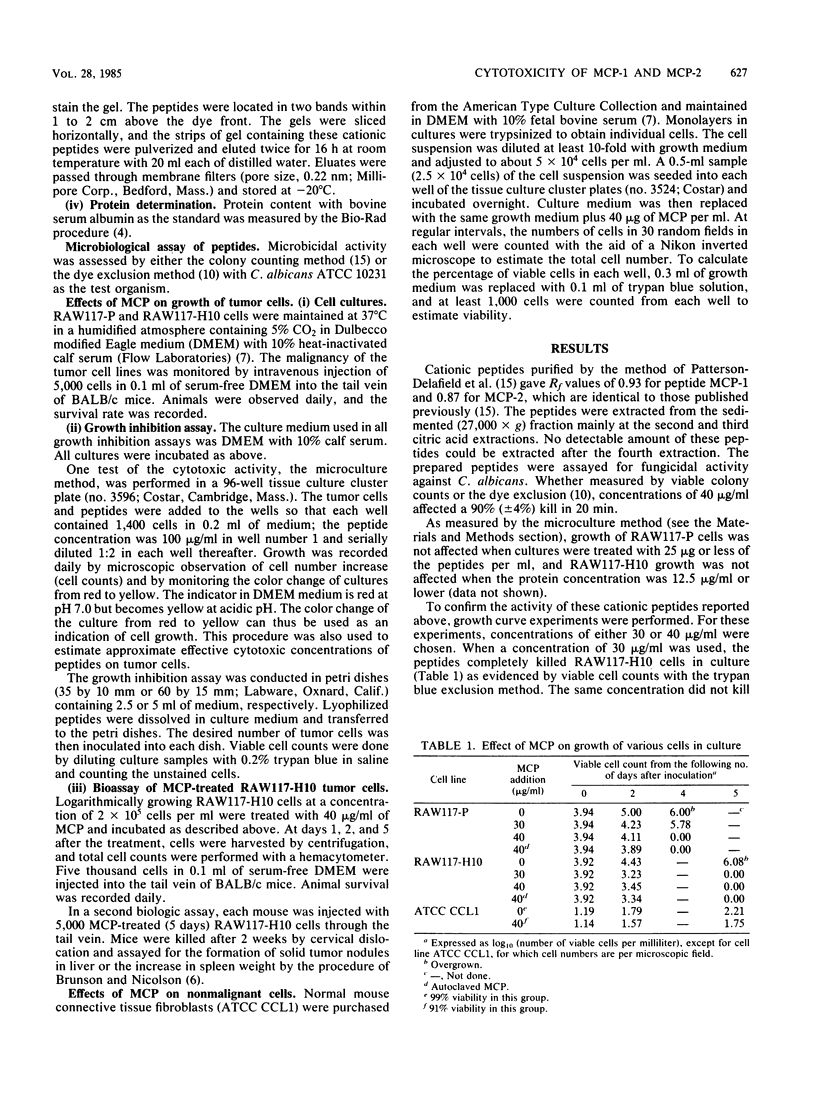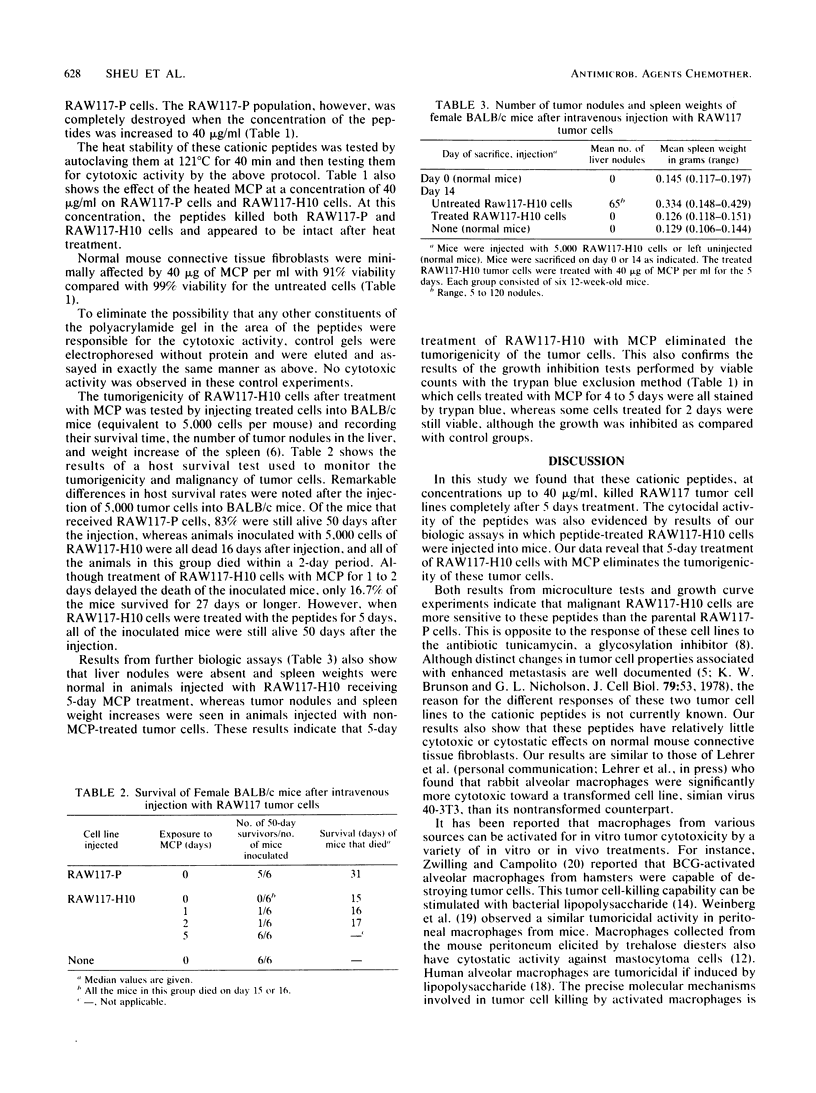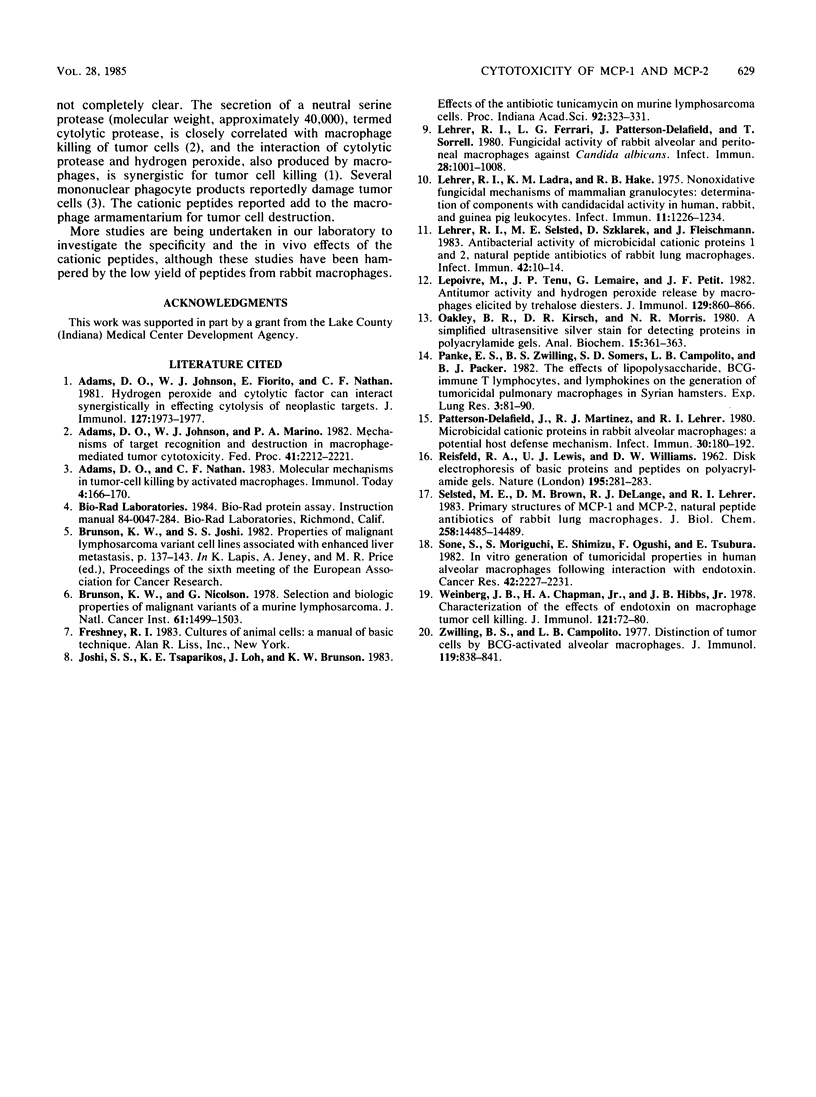Abstract
The cytotoxicity of cationic peptides MCP-1 and MCP-2 isolated from rabbit alveolar macrophages was tested against two tumor cell lines of murine lymphosarcoma origin, RAW117-P and RAW117-H10, and a normal mouse connective tissue fibroblast strain, ATCC CCL1.RAW117-H10 is a highly malignant metastatic variant derived from the less malignant RAW117-P. Our results indicate that these peptides possess a cytotoxic activity against the tumor cells tested but not against the normal cells tested. At concentrations of 30 micrograms/ml, these peptides completely killed RAW117-H10 cells in suspension cultures, while inhibiting growth of RAW117-P for but a limited period of time, up to 48 h, after which growth resumed. RAW117-P cells were killed by concentrations of 40 micrograms/ml. These peptides showed little cytotoxicity for normal mouse connective tissue fibroblasts at concentrations of 40 micrograms/ml.
Full text
PDF



Selected References
These references are in PubMed. This may not be the complete list of references from this article.
- Adams D. O., Johnson W. J., Fiorito E., Nathan C. F. Hydrogen peroxide and cytolytic factor can interact synergistically in effecting cytolysis of neoplastic targets. J Immunol. 1981 Nov;127(5):1973–1977. [PubMed] [Google Scholar]
- Adams D. O., Johnson W. J., Marino P. A. Mechanisms of target recognition and destruction in macrophage-mediated tumor cytotoxicity. Fed Proc. 1982 Apr;41(6):2212–2221. [PubMed] [Google Scholar]
- Brunson K. W., Nicolson G. L. Selection and biologic properties of malignant variants of a murine lymphosarcoma. J Natl Cancer Inst. 1978 Dec;61(6):1499–1503. [PubMed] [Google Scholar]
- Lehrer R. I., Ferrari L. G., Patterson-Delafield J., Sorrell T. Fungicidal activity of rabbit alveolar and peritoneal macrophages against Candida albicans. Infect Immun. 1980 Jun;28(3):1001–1008. doi: 10.1128/iai.28.3.1001-1008.1980. [DOI] [PMC free article] [PubMed] [Google Scholar]
- Lehrer R. I., Ladra K. M., Hake R. B. Nonoxidative fungicidal mechanisms of mammalian granulocytes: demonstration of components with candidacidal activity in human, rabbit, and guinea pig leukocytes. Infect Immun. 1975 Jun;11(6):1226–1234. doi: 10.1128/iai.11.6.1226-1234.1975. [DOI] [PMC free article] [PubMed] [Google Scholar]
- Lehrer R. I., Selsted M. E., Szklarek D., Fleischmann J. Antibacterial activity of microbicidal cationic proteins 1 and 2, natural peptide antibiotics of rabbit lung macrophages. Infect Immun. 1983 Oct;42(1):10–14. doi: 10.1128/iai.42.1.10-14.1983. [DOI] [PMC free article] [PubMed] [Google Scholar]
- Lepoivre M., Tenu J. P., Lemaire G., Petit J. F. Antitumor activity and hydrogen peroxide release by macrophages elicited by trehalose diesters. J Immunol. 1982 Aug;129(2):860–866. [PubMed] [Google Scholar]
- Oakley B. R., Kirsch D. R., Morris N. R. A simplified ultrasensitive silver stain for detecting proteins in polyacrylamide gels. Anal Biochem. 1980 Jul 1;105(2):361–363. doi: 10.1016/0003-2697(80)90470-4. [DOI] [PubMed] [Google Scholar]
- Panke E. S., Zwilling B. S., Somers S. D., Campolito L. B., Packer B. J. The effects of lipopolysaccharide, BCG-immune T lymphocytes, and lymphokines on generations of tumoricidal pulmonary macrophages in Syrian hamster. Exp Lung Res. 1982 Feb;3(1):81–90. doi: 10.3109/01902148209115818. [DOI] [PubMed] [Google Scholar]
- Patterson-Delafield J., Martinez R. J., Lehrer R. I. Microbicidal cationic proteins in rabbit alveolar macrophages: a potential host defense mechanism. Infect Immun. 1980 Oct;30(1):180–192. doi: 10.1128/iai.30.1.180-192.1980. [DOI] [PMC free article] [PubMed] [Google Scholar]
- REISFELD R. A., LEWIS U. J., WILLIAMS D. E. Disk electrophoresis of basic proteins and peptides on polyacrylamide gels. Nature. 1962 Jul 21;195:281–283. doi: 10.1038/195281a0. [DOI] [PubMed] [Google Scholar]
- Selsted M. E., Brown D. M., DeLange R. J., Lehrer R. I. Primary structures of MCP-1 and MCP-2, natural peptide antibiotics of rabbit lung macrophages. J Biol Chem. 1983 Dec 10;258(23):14485–14489. [PubMed] [Google Scholar]
- Sone S., Moriguchi S., Shimizu E., Ogushi F., Tsubura E. In vitro generation of tumoricidal properties in human alveolar macrophages following interaction with endotoxin. Cancer Res. 1982 Jun;42(6):2227–2231. [PubMed] [Google Scholar]
- Weinberg J. B., Chapman H. A., Jr, Hibbs J. B., Jr Characterization of the effects of endotoxin on macrophage tumor cell killing. J Immunol. 1978 Jul;121(1):72–80. [PubMed] [Google Scholar]
- Zwilling B. S., Campolito L. B. Destruction of tumor cells by BCG-activated alqolar macrophages. J Immunol. 1977 Sep;119(3):838–841. [PubMed] [Google Scholar]


